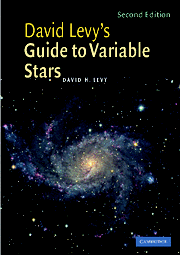Book contents
- Frontmatter
- Contents
- Foreword to the first edition
- Preface
- Acknowledgments
- Part I Getting to know the sky
- 1 Beginning with the Big Dipper
- 2 Magnitude, color, and distance
- 3 A word on binoculars and telescopes
- 4 Learning to see
- Part II Getting to know the variables
- Part III Suggested variables for observation throughout the year
- Part IV A miscellany
- Index
4 - Learning to see
from Part I - Getting to know the sky
Published online by Cambridge University Press: 05 August 2012
- Frontmatter
- Contents
- Foreword to the first edition
- Preface
- Acknowledgments
- Part I Getting to know the sky
- 1 Beginning with the Big Dipper
- 2 Magnitude, color, and distance
- 3 A word on binoculars and telescopes
- 4 Learning to see
- Part II Getting to know the variables
- Part III Suggested variables for observation throughout the year
- Part IV A miscellany
- Index
Summary
Training your eye
Learning to see is the most important skill in all visual observing, whether with the sky or in any other aspect of Nature. Noticing what's happening around you is an important skill to have – my grandfather taught me to look for the details in Nature – the flower that grows unexpectedly where one wouldn't expect it, the tree whose branches soar toward the sky in an unusual way. Variable-star observing provides very good training in seeing. Seeing is an art to be developed, a beautiful capability within you that must be nurtured and cultivated. When it blossoms, the quality of your observations, whether they involve describing a tree or the brightness of a star, will increase dramatically. After Sir William Herschel discovered the planet Uranus in 1781, he described how the quality of his instruments enabled him to make detailed observations at high magnifications. Even today such powers are practically unheard of, and the astronomers of his time questioned his ability to see at such gargantuan magnifications. Herschel replied with confidence: “Seeing is in some respects an art which must be learnt. To make a person see with such power is nearly the same as if I were asked to make him play one of Handel's fugues upon the organ. Many a night have I been practicing to see, and it would be strange if one did not acquire a certain dexterity by such constant practice.”
- Type
- Chapter
- Information
- David Levy's Guide to Variable Stars , pp. 20 - 22Publisher: Cambridge University PressPrint publication year: 2005
- 1
- Cited by

